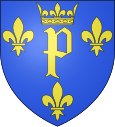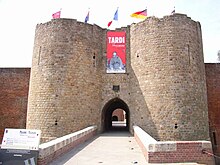Péronne
| Péronne | ||
|---|---|---|

|
|
|
| region | Hauts-de-France | |
| Department | Somme | |
| Arrondissement | Péronne | |
| Canton | Péronne (main town) | |
| Community association | Haute Somme | |
| Coordinates | 49 ° 56 ' N , 2 ° 56' E | |
| height | 47-117 m | |
| surface | 14.16 km 2 | |
| Residents | 7,579 (January 1, 2017) | |
| Population density | 535 inhabitants / km 2 | |
| Post Code | 80200 | |
| INSEE code | 80620 | |
| Website | www.ville-peronne.fr | |
Péronne is a French municipality with 7579 inhabitants (at January 1, 2017) in the department of Somme in the region of Hauts-de-France .
location
The city lies at the confluence of the Cologne in the Somme ; there are also the two canals Canal du Nord and Canal de la Somme . There are numerous ponds in the urban area.
history
The place name indicates a Celtic origin Péronnes. Péronne developed in the Merovingian period and was the capital of the historic French province of Santerre . King Guntram I issued a capitular here in 585 . The caretaker Erchinoald built the church of St. Fursy here around 655 under the reign of Clovis II , which became a planting place for Irish monasticism in the Franconian Empire and flourished until the time of the French Revolution . From the 9th century there was also a mint in Péronne.
The French King Rudolf transferred Péronne to Count Heribert II in 924. With this, the city came into the possession of the Counts of Vermandois . Heribert II now held the deposed King Charles III, the simple- minded, prisoner in Péronne until his death on October 7, 929. A noble family that bore the lead name Robert ruled the city from 1028 to 1105. Representatives of this aristocratic family, as lords of Péronne, had permanent feudal relationships with the Counts of Vermandois and were able to benefit from the economic importance of the place. To the south they controlled a certain stretch of the Somme river; to the north they could exert influence as far as Bapaume . In the early 12th century, a new noble dynasty came to power in Péronne, which probably had closer ties to the Counts of Vermandois. The surrounding territory controlled by her was therefore no longer referred to as seigneurie , but as castellany .
After the death of Philip of Alsace (1191), Péronne, which he had inherited through his wife , fell to the French crown during the reign of King Philip II August . A royal Prévôt now resided in the place . Philip August and the Flemish Count Balduin IX. signed the so-called Peace of Péronne 1200 here . In 1209, Philipp August granted the town town charter with several privileges, and King Charles V renewed both in 1368. As lords of Péronne, the French kings had their own coins minted here; they also chose the city as their place of residence more often. Louis IX announced in Péronne on September 24, 1256 his arbitration (so-called Dit de Péronne) in a succession dispute between the houses of Dampierre and Avesnes .
In 1435, King Charles VII. Péronne and other cities on the Somme ceded to Philip the Good of Burgundy in the Treaty of Arras . 1463 by the French King Louis XI. bought back, Péronne fell back to the Burgundian Duke Charles the Bold as early as 1465 . When Louis XI. In 1468, following an invitation from Charles the Bold to Péronne, he was imprisoned here and forced to sign a treaty on October 14, which obliged him to make great concessions and to take part in the vengeance against Liège . After the death of Charles the Bold (1477), Louis XI took possession. back to the city. Mary of Burgundy reclaimed Péronne in vain, and in the Peace of Madrid in 1526, Péronne was formally ceded to France by Emperor Charles V.
Count Heinrich III. of Nassau besieged that of Robert III. de La Marck defended Péronne in vain for a month in 1536. For this brave resistance, the inhabitants of Péronne were granted various privileges by King Francis I , such as a crowned "P" between three golden lilies as a coat of arms. In 1576 the city joined the Holy League during the Wars of Religion .
On June 26, 1815, during the retreat of the French army after the defeat at Waterloo , Péronne was taken by the British under Wellington in the first assault. In the Franco-Prussian War of 1870/71, the city was enclosed by the Germans on December 27, 1870 and bombed for two weeks. Péronne was forced to surrender on January 9, 1871, due to the suffering of the civilian population, among whom smallpox was rampant.
The place was also destroyed in the First and Second World Wars . During the First World War, Péronne was on the German western front . On September 2, 1918, Australian troops succeeded in taking Péronnes. An 80-kilometer circular route leads from Péronne over the historic battlefields of the Somme u. a. to the French and British memorials of Rancourt and Thiepval near Pozières .
Culture and sights
- A modern museum building on the history of the First World War, the Historial de la Grande Guerre , designed by Henri Ciriani , was integrated into the castle ruins in 1992 . Here parallels between the three main opponents of the war, France, the British Empire and the German Empire, are shown and historical and sociological dimensions of the war are illustrated using the remains of the war, posters and film documents. One of the works of art on display is the etching cycle Der Krieg by German artist and World War II participant Otto Dix .
- Only the Porte de Bretagne remains from the earlier fortifications .
- The Gothic hall church of Saint-Jean-Baptiste dates from the early 16th century.
See also Saint Fursy
traffic
In Péronne branches from the highway A1 , the (Paris-Lille) A2 to Brussels from. Paris is about 140 km away; it is 29 km to St. Quentin and 50 km to Arras . The Péronne-Saint Quentin airfield, 12 km southeast, is used for general aviation.
Town twinning
The congregation is related to Altena in Germany and to Blackburn in England .
Personalities
- Louis-Mathieu Langlès (1763–1824), philologist and translator
- Pierre Mac Orlan (1882–1970), writer
Web links
- ville-peronne.fr Official website of the city (French)
- ot-peronne.fr City Tourist Office (French / English / German)
- historial.org Museum L'Historial de la Grand Guerre
Remarks
- ↑ a b c d O. Guyotjeannin: Péronne . In: Lexicon of the Middle Ages (LexMA). Volume 6, Artemis & Winkler, Munich / Zurich 1993, ISBN 3-7608-8906-9 , Sp. 1894.
- ^ A b G. MS Fischer: Péronne . In: Johann Samuelersch , Johann Gottfried Gruber (Ed.): Allgemeine Encyclopädie der Wissenschaften und Künste , 3rd Section, Vol. 17 (1842), p. 197.
- ↑ a b Péronne . In: Meyers Konversations-Lexikon . 4th edition. Volume 12, Verlag des Bibliographisches Institut, Leipzig / Vienna 1885–1892, p. 858.


